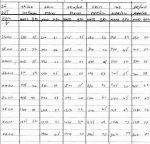Re: FlowVis for In-floor Cleaning System Tuning
Mark, I claimed 50% increase in "Power Efficiency" (whatever that term means haha) as a comparison of my "original configuration" performance (2749 Gallons/kWh filtered) to my "final configuration" performance (4251 Gallons/kWh filtered).
As I said in my last response to dodger, I concede that both "flow rate from the manifold" AND "pressure in the manifold" must be decreased (partly because both of you seem knowledgeable and adamant about that and I can't test it). But I am maintaining that the flow rate from the manifold has not been significantly impacted by slightly opening the pool wall returns (2-notch Jandy stop adjustment). [although the PSI dropped significantly, the flow rate (gpm) did not change as much. How much it actually impacted "cleaning" is unclear as I was overdriving the popups in both of these cases]
BTW, I also now concede that there must be some portion (I believe small) of the flow of water to the manifold in my "original configuration" is being "redirected or diverted" to the wall returns in my "final configuration" (this naturally follows from prior paragraph)...something I discussed with dodger earlier.
But didn't you claim a 50% decrease in energy use (in red too)? I still don't think you are comparing apples to apples. The three scenarios do not have the same flow rate to the in-floors. As you redirect flow to the wall ports, the RPM must go up to compensate and deliver the same flow rate to the in-floors. As I stated before, the in-floor manifold must maintain the same pressure in order to maintain the same flow rate.
Mark, I claimed 50% increase in "Power Efficiency" (whatever that term means haha) as a comparison of my "original configuration" performance (2749 Gallons/kWh filtered) to my "final configuration" performance (4251 Gallons/kWh filtered).
As I said in my last response to dodger, I concede that both "flow rate from the manifold" AND "pressure in the manifold" must be decreased (partly because both of you seem knowledgeable and adamant about that and I can't test it).
BTW, I also now concede that there must be some portion (I believe small) of the flow of water to the manifold in my "original configuration" is being "redirected or diverted" to the wall returns in my "final configuration" (this naturally follows from prior paragraph)...something I discussed with dodger earlier.




 :
: